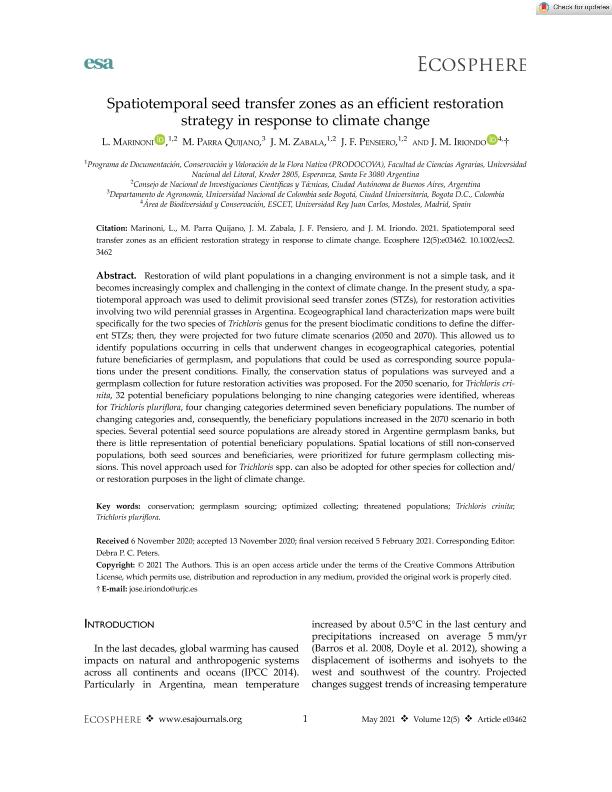Mostrar el registro sencillo del ítem
dc.contributor.author
Marinoni, Lorena del Rosario

dc.contributor.author
Parra Quijano, Héctor Mauricio

dc.contributor.author
Zabala, Juan Marcelo

dc.contributor.author
Pensiero, Jose Francisco

dc.contributor.author
Iriondo Alegría, José María

dc.date.available
2022-10-03T10:00:31Z
dc.date.issued
2021-05
dc.identifier.citation
Marinoni, Lorena del Rosario; Parra Quijano, Héctor Mauricio; Zabala, Juan Marcelo; Pensiero, Jose Francisco; Iriondo Alegría, José María; Spatiotemporal seed transfer zones as an efficient restoration strategy in response to climate change; John Wiley & Sons Inc.; Ecosphere; 12; 5; 5-2021; 1-19
dc.identifier.issn
2150-8925
dc.identifier.uri
http://hdl.handle.net/11336/171382
dc.description.abstract
Restoration of wild plant populations in a changing environment is not a simple task, and it becomes increasingly complex and challenging in the context of climate change. In the present study, a spatiotemporal approach was used to delimit provisional seed transfer zones (STZs), for restoration activities involving two wild perennial grasses in Argentina. Ecogeographical land characterization maps were built specifically for the two species of Trichloris genus for the present bioclimatic conditions to define the different STZs; then, they were projected for two future climate scenarios (2050 and 2070). This allowed us to identify populations occurring in cells that underwent changes in ecogeographical categories, potential future beneficiaries of germplasm, and populations that could be used as corresponding source populations under the present conditions. Finally, the conservation status of populations was surveyed and a germplasm collection for future restoration activities was proposed. For the 2050 scenario, for Trichloris crinita, 32 potential beneficiary populations belonging to nine changing categories were identified, whereas for Trichloris pluriflora, four changing categories determined seven beneficiary populations. The number of changing categories and, consequently, the beneficiary populations increased in the 2070 scenario in both species. Several potential seed source populations are already stored in Argentine germplasm banks, but there is little representation of potential beneficiary populations. Spatial locations of still non-conserved populations, both seed sources and beneficiaries, were prioritized for future germplasm collecting missions. This novel approach used for Trichloris spp. can also be adopted for other species for collection and/or restoration purposes in the light of climate change.
dc.format
application/pdf
dc.language.iso
eng
dc.publisher
John Wiley & Sons Inc.

dc.rights
info:eu-repo/semantics/openAccess
dc.rights.uri
https://creativecommons.org/licenses/by/2.5/ar/
dc.subject
CONSERVATION
dc.subject
GERMPLASM SOURCING
dc.subject
OPTIMIZED COLLECTING
dc.subject
THREATENED POPULATIONS
dc.subject
TRICHLORIS CRINITA
dc.subject
TRICHLORIS PLURIFLORA
dc.subject.classification
Otras Ciencias de la Tierra y relacionadas con el Medio Ambiente

dc.subject.classification
Ciencias de la Tierra y relacionadas con el Medio Ambiente

dc.subject.classification
CIENCIAS NATURALES Y EXACTAS

dc.title
Spatiotemporal seed transfer zones as an efficient restoration strategy in response to climate change
dc.type
info:eu-repo/semantics/article
dc.type
info:ar-repo/semantics/artículo
dc.type
info:eu-repo/semantics/publishedVersion
dc.date.updated
2022-09-29T12:18:33Z
dc.identifier.eissn
2150-8925
dc.journal.volume
12
dc.journal.number
5
dc.journal.pagination
1-19
dc.journal.pais
Estados Unidos

dc.journal.ciudad
Washington
dc.description.fil
Fil: Marinoni, Lorena del Rosario. Consejo Nacional de Investigaciones Científicas y Técnicas. Instituto de Ciencias Agropecuarias del Litoral. Universidad Nacional del Litoral. Instituto de Ciencias Agropecuarias del Litoral; Argentina. Universidad Nacional del Litoral. Facultad de Ciencias Agrarias; Argentina
dc.description.fil
Fil: Parra Quijano, Héctor Mauricio. Universidad Nacional de Colombia; Colombia
dc.description.fil
Fil: Zabala, Juan Marcelo. Consejo Nacional de Investigaciones Científicas y Técnicas. Instituto de Ciencias Agropecuarias del Litoral. Universidad Nacional del Litoral. Instituto de Ciencias Agropecuarias del Litoral; Argentina. Universidad Nacional del Litoral. Facultad de Ciencias Agrarias; Argentina
dc.description.fil
Fil: Pensiero, Jose Francisco. Consejo Nacional de Investigaciones Científicas y Técnicas. Instituto de Ciencias Agropecuarias del Litoral. Universidad Nacional del Litoral. Instituto de Ciencias Agropecuarias del Litoral; Argentina. Universidad Nacional del Litoral. Facultad de Ciencias Agrarias; Argentina
dc.description.fil
Fil: Iriondo Alegría, José María. Universidad Rey Juan Carlos; España
dc.journal.title
Ecosphere
dc.relation.alternativeid
info:eu-repo/semantics/altIdentifier/url/https://esajournals.onlinelibrary.wiley.com/doi/full/10.1002/ecs2.3462
dc.relation.alternativeid
info:eu-repo/semantics/altIdentifier/doi/https://doi.org/10.1002/ecs2.3462
Archivos asociados
